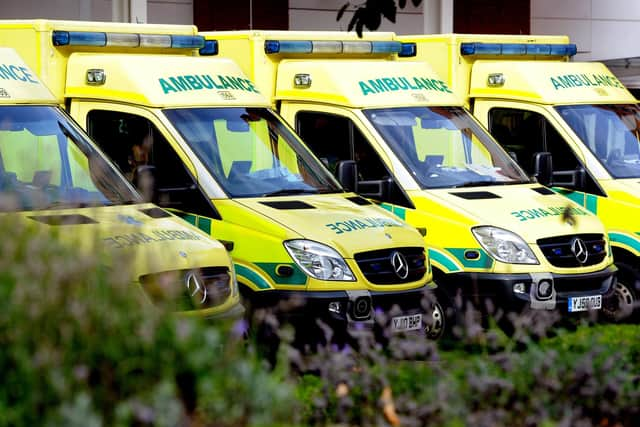East Midlands Ambulance Service receives 5,000 calls in a single day
and live on Freeview channel 276
The theme for our local NHS services this summer is that it is not a more quiet period, like it should be, with staff stretched further after 18 months of intense pressure.
Such is the strain on services that at one point in July, East Midlands Ambulance Service received 5,000 calls in a single day – with 2,500 typically deemed a “challenging” day.
Advertisement
Hide AdAdvertisement
Hide AdEach day throughout July, EMAS says, has seen around 1,000 calls for service.


This is 40 per cent higher than in July 2019 – before the pandemic – with most days busier than the traditionally hectic days, including New Year’s Eve.
All this is ahead of winter, which usually presents the year’s highest pressure for services.
EMAS has endeavoured to make the very most of its available time and treat more people at home as opposed to transporting them to a hospital.
Advertisement
Hide AdAdvertisement
Hide AdIt says that 42 per cent of patients were treated at home in July.
However, it says visits to patients by ambulance crews have increased, with eight per cent more visits in July than in July 2019 – around 140 more responses per day.
Tim Slater, divisional director for East Midlands Ambulance Service in Derbyshire, said that thousands of hours continue to be lost in handover delays – where patients are transferred from an ambulance to a hospital.
However he does say the figure for “lost hours” is far lower than in 2019.
MORE HEALTH NEWS: Test tube shortage leads to Derbyshire blood test cancellations
Advertisement
Hide AdAdvertisement
Hide AdWhile these handover delays rarely see a patient left waiting in an ambulance outside a hospital, it does frequently see an ambulance effectively stranded and unavailable for a callout to a possible emergency.
Crucially, this can see residents who have called 999 waiting longer for their ambulance to arrive and some delays to patients being treated at hospital.
During 2020, EMAS lost a total of 5,000 shifts’ worth of time or 2,500 days’ worth waiting for hospital handovers.
Derby and Derbyshire Clinical Commissioning Group board papers show that for patients in the county, most delays occurred at Royal Derby Hospital.
Advertisement
Hide AdAdvertisement
Hide AdThe papers show that, in June, there were 869 “lost hours” caused by handover delays at Royal Derby Hospital, equating to 36 lost days idling and unavailable for callout.
Meanwhile, there were 425 “lost hours” at Chesterfield Royal Hospital, the equivalent of 17 lost days, in June alone.
Mr Slater said: “When patients do need hospital care, emergency departments are often busy on arrival, through dealing with patients who have walked into the unit.
“The challenge this creates for ambulance crews is that when they arrive at a full emergency department, they may need to stay longer with a patient for an extended period before a hospital clinician is available to take over the care.
Advertisement
Hide AdAdvertisement
Hide Ad“The outcome for patients of handover delays is obvious, with delays in getting crews back out on the road, patients waiting longer in the community, often without a medical professional present, for a 999-ambulance response.
“Patients also experience some delay in getting the hospital treatment they need.
“The situation also impacts on staff wellbeing, morale and sickness levels.”
The papers show that in July, 300 patients were “awaiting an allocation” from EMAS call centre staff, putting “huge pressure” on employees.
Advertisement
Hide AdAdvertisement
Hide AdThey also detail that the Midlands region “has the highest level of patients waiting outside a hospital”.
Pressure on our ambulance services, including staff absence due to Covid, has led to an impact on callout responses.
The papers detail that in July, a category one callout – the most urgent – in Derbyshire took an average of nine minutes, while the target was seven minutes.
It has not met this target for 13 consecutive months.
Meanwhile a category two response – the second highest based on urgency – in Derbyshire, in July, took an average of 45 minutes.
The target was 18 minutes, which it has not met for a year.
Advertisement
Hide AdAdvertisement
Hide AdFor category three callouts, 90 per cent of responses are supposed to be carried out within two hours, but EMAS crews in Derbyshire in July clocked in at nearly seven hours for the time in which 90 per cent of callouts were attended.
Rachel Traveller, assistant service manager for the acute care unit at Chesterfield Royal Hospital, said: “We’re continuing to see an increase in the number of people coming through the doors of our emergency department, but we have a good record for seeing, treating, admitting or discharging within the national four hour standard.
“There has been a significant demand on services across the entire NHS system, coupled with a staff shortage caused by illness and Covid-related isolation that has increased this pressure and impacted our ability to consistently meet the 15 minute target to handover ambulance patients.
“But at no point will our patients be left to wait outside or in ambulances; they wait in our emergency department upon arrival whilst the handover takes place.”
Advertisement
Hide AdAdvertisement
Hide AdOn the role of the city council in keeping the health system moving, Cllr Roy Webb, the authority’s cabinet member for adults, health and housing, said: “The role of adult social care service’s in making sure hospitals are able to treat all patients is not widely known among the general public, but is a vital cog in the wheel.
“Any delay at this stage in the care journey sees a ripple effect back through the rest of the hospital, which ultimately can result in possible ambulance delays at the hospital front door.”